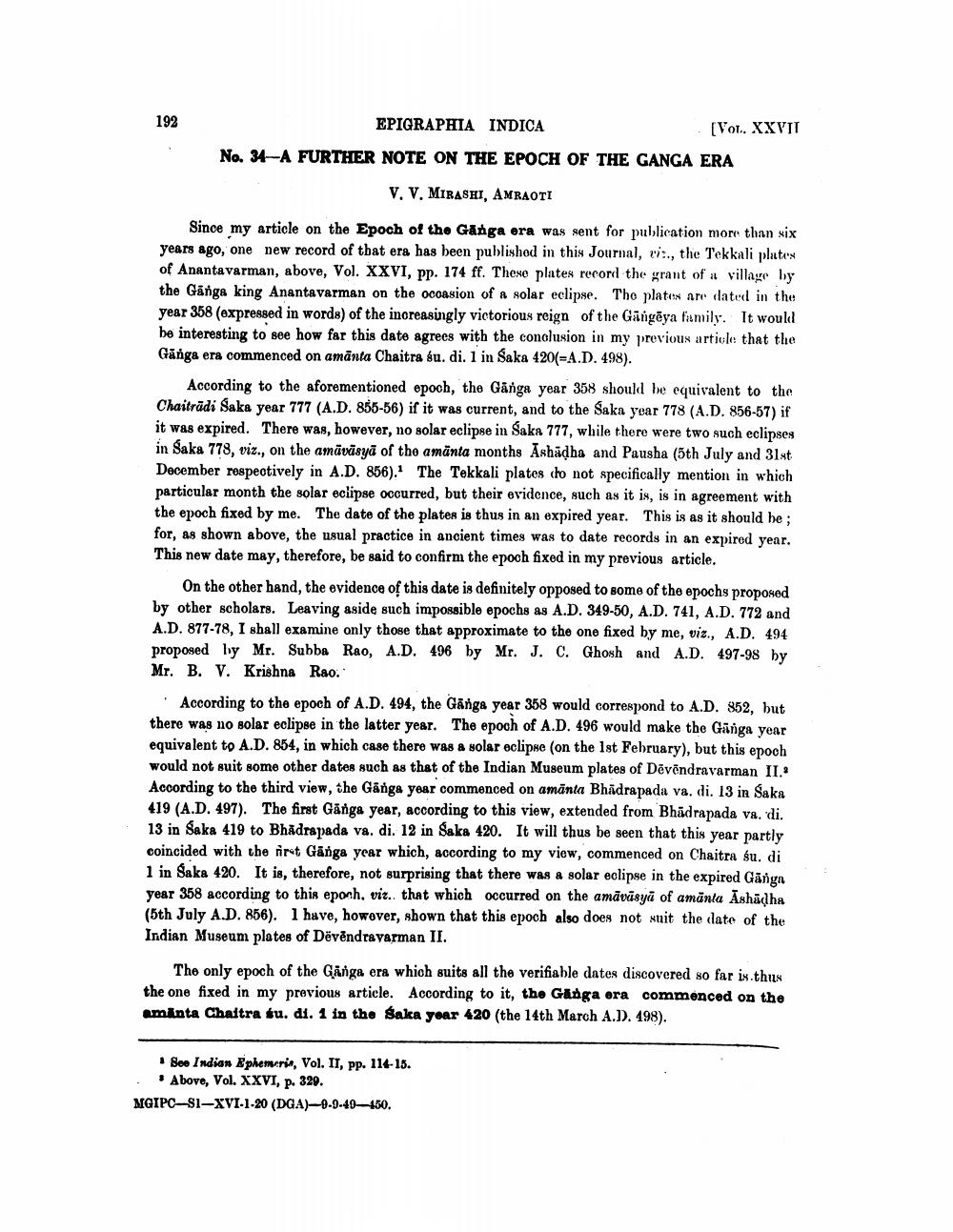________________
EPIGRAPHIA INDICA
[Vol. XXVII No. 34-A FURTHER NOTE ON THE EPOCH OF THE GANGA ERA
V. V. MIRASHI, AMRAOTI
Since my article on the Epoch of the Ganga era was sent for publication more than six years ago, one new record of that era has been published in this Journal, viz., the Tekkali plates of Anantavarman, above, Vol. XXVI, pp. 174 ff. These plates record the grant of a village by the Gănga king Anantavarman on the occasion of a solar eclipse. Tho plates are dated in the year 358 (expressed in words) of the increasingly victorious reign of the Gānigēya family. It would be interesting to see how far this date agrees with the conclusion in my previous article that the Gänga era commenced on amānta Chaitra su. di. 1 in Saka 420(=A.D. 498).
According to the aforementioned epoch, the Gänga year 358 should be equivalent to the Chaitrādi Saka year 777 (A.D. 855-56) if it was current, and to the Saka year 778 (A.D. 856-57) if it was expired. There was, however, no solar eclipse in Saka 777, while there were two such eclipses in Saka 778, viz., on the amāvisyū of the amänta months Ashādha and Pausha (5th July and 31st December respeotively in A.D. 856). The Tekkali plates (ho not specifically mention in which particular month the solar eclipse occurred, but their evidence, such as it is, is in agreement with the epoch fixed by me. The date of the plates is thus in an expired year. This is as it should be ; for, as shown above, the usual practice in ancient times was to date records in an expired year. This new date may, therefore, be said to confirm the epoch fixed in my previous article.
On the other hand, the evidence of this date is definitely opposed to some of the epochs proposed by other scholars. Leaving aside such impossible epochs as A.D. 349-50, A.D. 741, A.D. 772 and A.D. 877-78, I shall examine only those that approximate to the one fixed by me, viz., A.D. 494 proposed liy Mr. Subba Rao, A.D. 496 by Mr. J. C. Ghosh and A.D. 497-98 hy Mr. B. V. Krishna Rao.
According to the epoch of A.D. 494, the Ganga year 358 would correspond to A.D. 852, but there was no solar eclipse in the latter year. The epoch of A.D. 496 would make the Ganga year equivalent to A.D. 854, in which case there was a solar eclipse (on the 1st February), but this epooh would not suit some other dates such as that of the Indian Museum plates of Dēvēndravarman II. According to the third view, the Gānga year commenced on amanta Bhädrapada va, di. 13 in Saka 419 (A.D. 497). The first Gănga year, according to this view, extended from Bhadrapada va. di. 13 in Saka 419 to Bhadrapada va. di. 12 in Saka 420. It will thus be seen that this year partly coincided with the first Gănga year which, according to my view, commenced on Chaitra su. di 1 in Saka 420. It is, therefore, not surprising that there was a solar eclipse in the expired Gāngn year 358 according to this eponh, vit. that which occurred on the amāvāsyā of amūnta Ashādha (5th July A.D. 856). 1 have, howover, shown that this epoch also does not suit the date of the Indian Museum plates of Dëvendravarman II.
The only epoch of the Ganga era which suits all the verifiable dates discovered so far is thus the one fixed in my previous article. According to it, the Ganga era commenced on the aminta Chaitra su. di. 1 in the Saka yoar 420 (the 14th March A.1). 498).
See Indian Ephemeris, Vol. II, pp. 114-15.
Above, Vol. XXVI, p. 329. MGIPC-S1-XVI-1-20 (DGA)-9-9-49—150.




